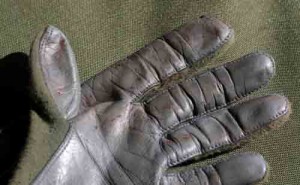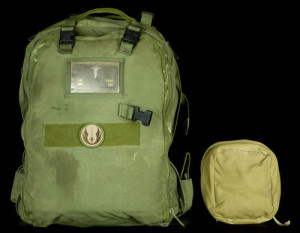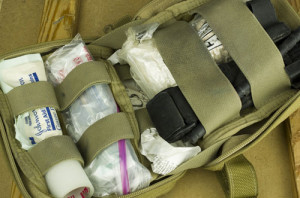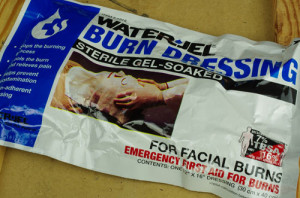Widgetized Section
Go to Admin » Appearance » Widgets » and move Gabfire Widget: Social into that MastheadOverlay zone
First Aid Gear For The Range Bag
Continues from page 1…
Protect Yourself First
Rushing forward to help someone in the event of a catastrophe sounds romantic, but you should make sure that it’s safe for you to do so before you jump in. If the injured person has been shot, secure the firearm. Mechanical failures are rare, but an injured person continuing to pull the trigger of a self-loading firearm after an injury is not uncommon. Also, the injured person might be downrange after having been shot by a careless person on the firing line – make sure that they aren’t going to put any more rounds downrange before you go to help.

Nitrile gloves are the best choice for protecting yourself from bodily fluids, but shooting gloves will work in a pinch
You should always have gloves with you at the range – nitrile gloves are a good choice. They will serve to protect your hands from bodily fluids, which you might soon come in contact with. You want to help your friend, but you also don’t want to find out the hard way that they brought home a few special gifts from that shore leave in Thailand back in the ’90s. Plus, you might be coming to the aid of a total stranger. Gloves are a must.
Equipment & Supplies
Here we go: the supply list. It is, after all, the core of this article; yet even here, I must answer with several caveats. Buying a big medical bag loaded with a ton of stuff is tempting, but detrimental if it takes up too much room in your car and you end up leaving it at home. On the other hand, having too few supplies might also be detrimental.
This is the difference between having an individual first aid kit, or what the military terms an IFAK, and a true medbag, which can vary from the size of a purse to the size of a large backpack. IFAKs are commonly available online, but their asking prices sometimes exceed the value of the items they contain by a large margin.
IFAKs are useful for treating one major injury, or, if you’re lucky, two. They are not intended to be used for a mass casualty scenario, and may not be enough for multiple gunshot wounds or other trauma. They are, however, extremely useful, they do not take up much space, and they do not cost very much to put together.
Medbags can be used to carry the supplies required to treat multiple injured persons. They can be large and heavy, preventing the carriage of other items that might be more useful, such as water or ammunition. The supplies required to fill a large medbag could easily reach over $1,000. While deployed, I carried extra supplies in my medbag to replenish the supplies of other Corpsmen I encountered who did not have regular access to supply lines.
Whatever supplies you choose, you must understand their purpose, function, and application.
When I set up IFAKs, I generally include the following:
- Tourniquet
- Pressure dressing
- 14ga IV catheter
- Gauze (4×4″ or Kerlix rolls)
- Small roll of perforated medical tape
- Chest seal
- Oropharyngeal/nasopharyngeal airways
- Small adhesive bandages
As medbags get larger, I include items such as:
- SAM Splints
- Water-Jel
- IV bags
- ABD pads
- More tourniquets, pressure dressings, gauze, etc.
- Sutures, ENT kits, scalpels, forceps, sterile gloves
- Morphine (if issued) and antibiotics as well as NSAIDs
As you may have noticed, some of the items I list are not what is commonly found in IFAKs for sale on the commercial market – and you might also have noticed the absence of QuikClot, which is popular in a lot of civilian first aid kits. At the risk of sounding arrogant, I do not recommend that the average person carry all of the items I listed.
The items I would recommend for a layman’s individual first aid kit are:
- Tourniquet
- Pressure dressing
- Gauze (4×4″ or Kerlix rolls)
- Small roll of perforated medical tape
- Chest seal
- Small adhesive bandages
- Knife, trauma shears, rescue hook, etc.
The reasons for the shorter list are fairly simple. Some of the items are not as necessary for the task at hand – Water-Jel is fantastic for burns, but burns are not often encountered at the shooting range.
On the other hand, some of the items not listed have the potential to cause more harm than good if used improperly, and it’s also critical to know when to not use them. If you have the proper training, then by all means, include them – but, for example, if you don’t have training on the subject of chest decompression, I would not advise playing darts with a human body, because that’s what the 14ga IV catheter is for.
Continues….






 MidwayUSA
MidwayUSA Ruger Firearms
Ruger Firearms SCCY Firearms
SCCY Firearms Streamlight
Streamlight Action Targets
Action Targets Gunsite Academy
Gunsite Academy
You must be logged in to post a comment Login